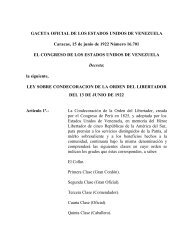Transverse waves on a string - People.fas.harvard.edu
Transverse waves on a string - People.fas.harvard.edu
Transverse waves on a string - People.fas.harvard.edu
Create successful ePaper yourself
Turn your PDF publications into a flip-book with our unique Google optimized e-Paper software.
dx2+dψ2 dx<br />
Figure 18<br />
dψ<br />
18 CHAPTER 4. TRANSVERSE WAVES ON A STRING<br />
because we defined impedance for <str<strong>on</strong>g>waves</str<strong>on</strong>g>. But the above <strong>string</strong> of balls is certainly similar<br />
to a l<strong>on</strong>gitudinal series of masses (with increasing size) and springs. The l<strong>on</strong>gitudinal <str<strong>on</strong>g>waves</str<strong>on</strong>g><br />
that travel al<strong>on</strong>g this spring/mass system c<strong>on</strong>sist of many “collisi<strong>on</strong>s” between the masses.<br />
In the original setup with just the <strong>string</strong> of balls and no springs, when two balls collide<br />
they smush a little and basically act like springs. Well, sort of; they can <strong>on</strong>ly repel and not<br />
attract. At any rate, if you abruptly increased the size of the masses in the spring/mass<br />
system by a large factor, then not much of the wave would make it through. But gradually<br />
increasing the masses would be just like gradually increasing the density µ in the “Gradually<br />
changing <strong>string</strong> density” example above.<br />
Lever: If you try to lift a refrigerator that is placed too far out <strong>on</strong> a lever, you’re not<br />
going to be able to do it. If you jumped <strong>on</strong> your end, you would just bounce off like <strong>on</strong> a<br />
springboard. You’d keep all of the energy, and n<strong>on</strong>e of it would be transmitted. But if you<br />
move the refrigerator inward enough, you’ll be able to lift it. However, if you move it in too<br />
far (let’s assume it’s a point mass), then you’re back to essentially not being able to lift it,<br />
because you’d have to move your end of the lever, say, a mile to lift the refrigerator up by<br />
a foot. So there is an optimal placement.<br />
Bicycle: The gears <strong>on</strong> a bike act basically the same way as a lever. If you’re in too high a<br />
gear, you’ll find that it’s too hard <strong>on</strong> your muscles; you can’t get going <strong>fas</strong>t. And likewise,<br />
if you’re in too low a gear, your legs will just spin wildly, and you’ll be able to go <strong>on</strong>ly so<br />
<strong>fas</strong>t. There is an optimal gear ratio that allows you to transfer the maximum amount of<br />
energy from chemical potential energy (from your previous meal) to kinetic energy.<br />
Rolling a ball up a ramp: This is basically just like a lever or a bike. If the ramp is<br />
too shallow, then the ball doesn’t gain much potential energy. And if it’s too steep, then<br />
you might not be able to move the ball at all.<br />
4.4 Energy<br />
Energy<br />
What is the energy of a wave? Or more precisely, what is the energy density per unit<br />
length? C<strong>on</strong>sider a little piece of the <strong>string</strong> between x and x + dx. In general, this piece<br />
has both kinetic and potential energy. The kinetic energy comes from the transverse moti<strong>on</strong><br />
(we showed in the paragraph following Eq. (1) that the l<strong>on</strong>gitudinal moti<strong>on</strong> is negligible),<br />
so it equals<br />
Kdx = 1<br />
2 (dm)v2 y = 1<br />
2 ∂ψ<br />
(µ dx) . (46)<br />
2 ∂t<br />
We have used the fact that since there is essentially no l<strong>on</strong>gitudinal moti<strong>on</strong>, the mass within<br />
the span from x to x + dx is always essentially equal to µ dx.<br />
The potential energy depends <strong>on</strong> the stretch of the <strong>string</strong>. In general, a given piece of<br />
the <strong>string</strong> is tilted and looks like the piece shown in Fig. 18. As we saw in Eq. (1), the Taylor<br />
series √ 1 + ɛ ≈ 1 + ɛ/2 gives the length of the piece as<br />
dx<br />
<br />
1 +<br />
2 ∂ψ<br />
≈ dx +<br />
∂x<br />
dx<br />
2<br />
2 ∂ψ<br />
. (47)<br />
∂x<br />
The piece is therefore stretched by an amount, dℓ ≈ (dx/2)(∂ψ/∂x) 2 . 5 This stretch is<br />
caused by the external tensi<strong>on</strong> forces at the two ends. These forces do an amount T dℓ of<br />
5 Actually, I think this result is rather suspect, although it doesn’t matter in the end. See the remark<br />
below.

















